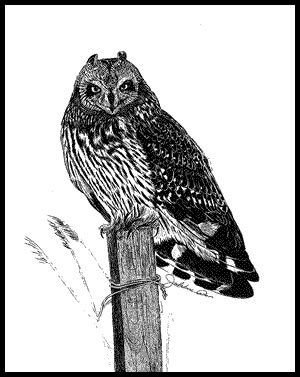| |
| |
| |
| |
| |
| |
| |
| |
| |
| |
| SHORT-EARED
OWL |
 |
The short-ear is one owl species that frequently hunts by day, especially if the day is overcast. You are most likely to spot it from midafternoon to dusk, although many people who do see this owl mistake it for a Northern harrier. The two species can be found in the same open areas, and both tend to range back and forth, searching for prey in a similar manner. However, the short-eared owl flies in an irregular, undulating style that is diagnostic. Its body seems to rise and fall with each wingbeat, while the wings give the impression of moving very little. The owl wears a distinctive black patch on the underside of its wings near the "wrist," at the base of the primary feathers. When perched, this crow-sized bird tilts forward, instead of standing upright as most other owls do. The two abbreviated ear tufts that give the species its common name are very small and inconspicuous, raised only when the bird goes on the alert. They lie close together near the center of the head, curving inward like miniature cow horns. When sitting the short-ear has a squat, bulky look that vanishes the instant it takes to the air. This owl has a big wingspan - 38 to 44 inches - to lift a small body. Weight ranges from only 7 ounces to 17 ounces. This low wingloading results in buoyant, silent flight. The short-eared owl's overall color is a warm tawny brown, with an overlay of blackish-brown striping on the back and on the flight feathers. The eyes are a striking shade of lemon yellow, set off by a black mask. The wide wingspan is a sign that the short-eared owl frequents open areas. It favors grasslands in the Southwest, tundra in the North, and marshes and coastal dunes elsewhere. It is found throughout North America, with the exception of the northern arctic. Its breeding range is much smaller, confined mostly to Canada and Alaska, although some birds nest as far south as Kansas. The short-ear is a ground-nester, and its nest is really no nest at all - just a shallow depression in or near a clump of grass or reeds. Four to seven eggs are usually laid in April or early May, although the number varies with the available food supply. The short-ear preys almost exclusively on field mice and voles. A pair with young can account for over a thousand rodents in the course of the nesting season. If several eggs are hatched, the nestlings will take up residence a few yards away from the nest, resulting in a family spread out over a wide area. The young may play dead if they're caught out in the open by a predator, and the adult birds know a few tricks, too - they'll feign an injured wing to lure intruders away from the nest area. The short-ear is not a particularly vocal owl. Its most characteristic cry is a bark, or a series of toot-toot-toots. During courtship a pair of birds will perform spectacular aerial maneuvers, flying so high that an observer may be barely able to make them out. At such times the owls indulge in steep dives, hitting their wingtips together with an audible clapping sound. The short-eared owl and its close relative the long-eared owl may be found in the same areas, even though they compete for the same prey. This joint ownership works because the long-ear is nocturnal, while the short-ear hunts by day. The long-eared owl is a secretive, forest-loving bird, and that and its nocturnal habits seem to protect it from human interference. The short-eared owl is not so fortunate. Its tendency to be abroad in daylight, as well as its choices of habitat, make it vulnerable to shooting. Habitat destruction, however, is the short-ear's greatest threat. |